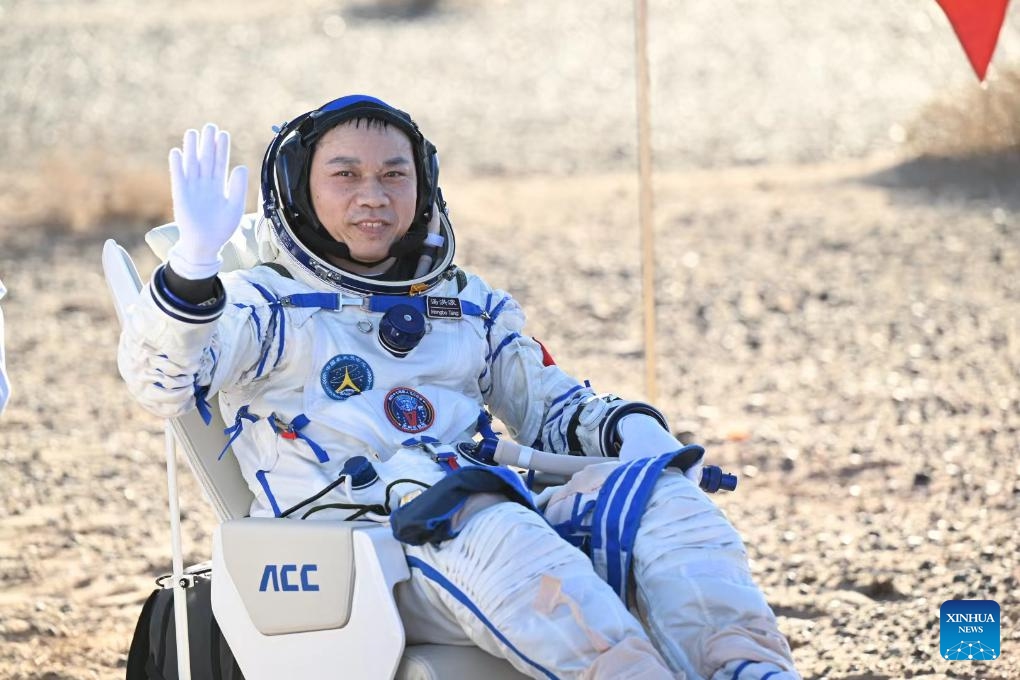Shenzhou-17 crew return to Earth after completing 1st extravehicular repair task for damages caused by space debris impact

The return capsule of the Shenzhou-17 manned spaceship, carrying taikonauts Tang Hongbo, Tang Shengjie and Jiang Xinlin, touched down at the Dongfeng landing site in North China's Inner Mongolia Autonomous Region on Tuesday, following six months aboard the Tiangong space station.
The three astronauts are all in good health condition, according to the China Manned Space Agency (CMSA), the Xinhua News Agency reported. China announced that the Shenzhou-17 mission was a complete success.
The Shenzhou-17 mission was launched on October 25, 2023, taking over control of Tiangong from the outgoing Shenzhou-16 crew days later. The crew departed the station at 8:43 am on Tuesday and landed at Dongfeng landing site at 17:46 pm.
Recovery crews were on the scene moments after the return capsule touched down. Mission commander Tang Hongbo was the first out of the capsule. In front of the camera of China Central Television, Tang expressed that he is very proud for the country. “I departed in autumn and came back in spring. My mood is just the like current days in April, the most beautiful season of a year,” Tang said.
Tang, who had first flown to space in the Shenzhou-12 mission in 2021 and then in the Shenzhou-17 mission, has not only become the taikonaut with the longest space flight time to date, but also the one with the shortest interval between two flight missions.
“Such an experience accumulated valuable lessons for us in the routine implementation of flight crew rotation and training,” CMSA spokesperson Lin Xiqiang said.
Shenzhou-17 is the second mission after Tiangong space station entered the application phase.
Prior to Shenzhou-17’s journey, research team had discovered damage on the solar wing cables of the station’s Tianhe core module due to space debris impact, resulting in partial power loss.
To fix the damage, the Shenzhou-17 crew brought repair tools with them to the space station, and through two extravehicular activities, they managed to complete China’s first extravehicular repair task, eliminating the impact on the core module's solar wings, the Global Times learned from the CMSA.
“This fully demonstrated the role of humans in space and showed that human care of spacecraft can better address unexpected issues in orbit,” Lin said.
Over the past few decades, especially in recent years, the rapid increase of human space activities has led to a growing concern over the issue of space debris. Up recently, the Chinese space station has actively implemented space debris avoidance measures on multiple occasions.
To cope with the challenge, China has improved its precise forecasting capabilities for the space station, optimizing space collision warning and reducing false alarm rates by 30 percent. China has also been conducting high-resolution inspection of the external status of Tiangong to analyze the probability and mechanics of small debris impacts.
The Shenzhou-18 crew who has just arrived at their space home on Friday will carry out reinforcement measures with protective devices to apply on the weak points on the exterior of the space station.
Lin noted that a space station impact leak monitoring and positioning system has also been deployed, improving emergency pressure response plans and increasing the time available for fault handling by five times.
The CMSA has been publishing OEM orbit parameters on their website, so as to establish a flight safety communication mechanism with other spacefaring countries, timely exchange and sharing of relevant information, with the aim of jointly maintaining the safety of spacecraft in orbit.
Apart from impact repair tasks, the Shenzhou-17 crew has conducted a total of 84 space application experiments, producing over 60 types of more than 200 samples in various fields such as space life sciences and biotechnology, aerospace medicine, and space materials science.
These samples will be brought back to Earth along with the Shenzhou-17 spacecraft for in-depth analysis and research. The samples are expected to achieve a number of important research results in areas such as high-performance multi-element alloys, functional crystal material preparation, and inhibiting bone loss through the differentiation of stem cells.